by Larry F. Johnson
[The Cobb County Courier has a general policy of sticking tightly to local news coverage, but there are some issues (e.g. immigration, COVID-19) that directly impact the county but have to be covered in the context of national and international news. So in those cases, we expand our scope]
A new variant of COVID-19 was discovered this month, with the first identified cases in southern Africa. Since then a number of countries have imposed travel bans from nations where cases have been reported, and the World Health Organization (WHO) has named it the Omicron variant and declared it a “Variant of Concern” (VOC).
Did the variant “originate” in South Africa
The answer to this is that no one knows where the variant first arose, and it has been found in multiple countries. South African scientists first discovered, announced, and began tracking the new variant.
Dr. Ingrid Katz, Associate Faculty Director of the Harvard Global Health Institute tweeted (while Omicron was still being called the “nu variant” in press reports):
I want to be clear about the nu variant.
— Ingrid Katz (@IngridKatzMD) November 26, 2021
We know what we know BECAUSE South Africa has invested in advanced genomic sequencing.
We owe them a debt of gratitude – not punishment.
Transparency is critical in a global pandemic. We need to support these efforts collaboratively.
Why is Omicron a “Variant of Concern”?
The World Health Organization designates whether a particular variant is a “Variant of Concern.”
The criteria the WHO uses are as follows, and a variant can be declared “of concern” if it meets one of those:
- Increase in transmissibility or detrimental change in COVID-19 epidemiology; OR
- Increase in virulence or change in clinical disease presentation; OR
- Decrease in effectiveness of public health and social measures or available diagnostics, vaccines, therapeutic
Early information provided by South African scientists indicates it might meet the first criterion of increased transmissibility.
There is so far no evidence that Omicron is more virulent or vaccine-resistant. However, the variant contains more mutations than previously identified variants.
The WHO published the following explanation of why it is considered a Variant of Concern:
This variant has a large number of mutations, some of which are concerning. Preliminary evidence suggests an increased risk of reinfection with this variant, as compared to other VOCs. The number of cases of this variant appears to be increasing in almost all provinces in South Africa. Current SARS-CoV-2 PCR diagnostics continue to detect this variant. Several labs have indicated that for one widely used PCR test, one of the three target genes is not detected (called S gene dropout or S gene target failure) and this test can therefore be used as marker for this variant, pending sequencing confirmation. Using this approach, this variant has been detected at faster rates than previous surges in infection, suggesting that this variant may have a growth advantage.
How rapidly is it spreading?
Reuters reports this morning that in addition to cases from South Africa, cases have been discovered in the UK, Germany, Italy, the Netherlands, Denmark, Belgium, Botswana, Israel, Australia, and Hong Kong.
BNO News, which has begun tracking reports from local sources, adds the Czech Republic and Austria to that list.
What do mutations in the “spike protein” signify?
Many of the news reports on the Omicron variant mention that scientists are worried about the large number of mutations in the spike protein in the variant.
A Q&A about the Omicron variant published by the Imperial College of London contained a quote from Professor Neil Ferguson, the Director of Imperial’s MRC Centre for Global Infectious Disease Analysis in which he states that the spike protein is the target of most vaccines, and a large number of mutations might give the virus a greater ability to escape prior immunity than previous variants.
Why is it named the Omicron variant?
In naming the variant Omicron, the WHO skipped two Greek letters, Nu and Xi.
Early reports actually began using the term “Nu variant” before the WHO officially named it the Omicron variant.
Nu was skipped because of the chance of mispronunciation as “new.” Xi was skipped because it’s a common Chinese name.
